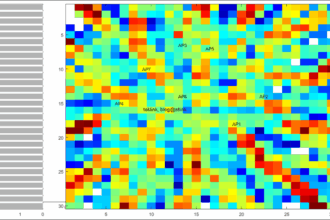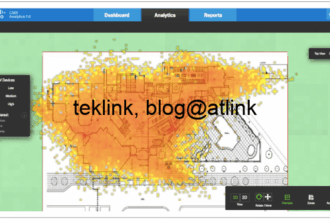In this post we present our work on RRM solution and we present our proposed machine learning (ML) optimization to a general operation of dynamic RRM. Please contact us for any question or report directly to the full text available at: An ML-optimized dRRM Solution for IEEE 802.11 Enterprise Wlan Networks.
What is this article about
We argue that in an enterprise Wifi network, indoor and dense, co-channel interference is a major issue. Hopefully, Wifi controllers help tackle this problem thanks to radio resource management (RRM). RRM which is a fundamental building block of any controller functional architecture. The next figure shows a situation where the wifi controller is into play. Both AP (access points) are associated with the same WLC (located in the datacenter) and provides him with two kinds of important information: 1) the first type of information relates to each AP individual measurement, 2) the second is to the relative AP measurements: for example using the OTA messages to tell what first AP sees via the second AP.

One aim of RRM is to process the radio plan such as to maximize the overall network transmit opportunity among all AP and WD (wireless devices).
Our dRRM solution based on Machine Learning
We present in this article: An ML-optimized dRRM Solution for IEEE 802.11 Enterprise Wlan Networks, our intial work on a dynamic RRM (dRRM) solution, WLCx (where x is the version of the solution), in contrast to other research and vendors’ solutions. Our solution model builds on a novel per-beam coverage representation approach that is discussed also in the same article. The main idea of WLCx is to allow more control over the architecture design aspects and recommendations. We demonstrated that this “dynamization” of RRM came at a price in terms of time and resources consumption.
To improve the scalability of our initial solution, we have introduced a Machine Learning (ML)-based optimization alternative to our N-WLCx solution described in this post: A NURBS Based Technique for an Optimized Transmit Opportunity Map Processing in WLAN Networks. We showed that our ML-optimized dRRM solution, M-WLCx, achieves almost 79.77% time reduction in comparison with the basic WLCx solution. The full description of our solution is presented in this article: https://astesj.com/v04/i06/p03/. In the next figure we show a visual comparative of two variants of our ML-based solution: BDT and SVM, to WLC2, our initial dRRM solution.
The main idea of the enhancement… as a summary

The main idea of our solution relies on the fact that it does not depend on any coverage model representation approach (or any analytical calculus). It relies rather and solely on the environmental variables which influence the phenomena under study to build a prediction model. This model could be described as an Out of Path model approach in contrast with the classic In Path approaches encountered in dRRM and sRRM solutions.





